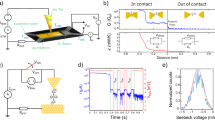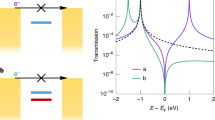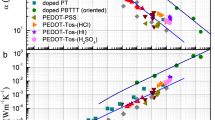Abstract
Theoretical studies suggest that mastering the thermocurrent through single molecules can lead to thermoelectric energy harvesters with unprecedentedly high efficiencies.1,2,3,4,5,6 This can be achieved by engineering molecule length,7 optimizing the tunnel coupling strength of molecules via chemical anchor groups8 or by creating localized states in the backbone with resulting quantum interference features.4 Empirical verification of these predictions, however, faces considerable experimental challenges and is still awaited. Here we use a novel measurement protocol that simultaneously probes the conductance and thermocurrent flow as a function of bias voltage and gate voltage. We find that the resulting thermocurrent is strongly asymmetric with respect to the gate voltage, with evidence of molecular excited states in the thermocurrent Coulomb diamond maps. These features can be reproduced by a rate-equation model only if it accounts for both the vibrational coupling and the electronic degeneracies, thus giving direct insight into the interplay of electronic and vibrational degrees of freedom, and the role of spin entropy in single molecules. Overall these results show that thermocurrent measurements can be used as a spectroscopic tool to access molecule-specific quantum transport phenomena.
This is a preview of subscription content, access via your institution
Access options
Access Nature and 54 other Nature Portfolio journals
Get Nature+, our best-value online-access subscription
$29.99 / 30 days
cancel any time
Subscribe to this journal
Receive 12 print issues and online access
$259.00 per year
only $21.58 per issue
Buy this article
- Purchase on Springer Link
- Instant access to full article PDF
Prices may be subject to local taxes which are calculated during checkout




Similar content being viewed by others
Data availability
Data for the main text are available online at https://doi.org/10.4121/13264931. Any other supporting data can be made available upon request to the corresponding author.
References
Gehring, P., Thijssen, J. M. & van der Zant, H. S. J. Single-molecule quantum-transport phenomena in break junctions. Nat. Rev. Phys. 1, 381–396 (2019).
Park, S., Kang, H. & Yoon, H. J. Structure–thermopower relationships in molecular thermoelectrics. J. Mater. Chem. A 7, 14419–14446 (2019).
Koch, J., von Oppen, F., Oreg, Y. & Sela, E. Thermopower of single-molecule devices. Phys. Rev. B 70, 195107 (2004).
Lambert, C. J., Sadeghi, H. & Al-Galiby, Q. H. Quantum-interference-enhanced thermoelectricity in single molecules and molecular films. C. R. Phys. 17, 1084–1095 (2016).
Murphy, P., Mukerjee, S. & Moore, J. Optimal thermoelectric figure of merit of a molecular junction. Phys. Rev. B 78, 161406 (2008).
Agarwalla, B. K., Jiang, J.-H. & Segal, D. Thermoelectricity in molecular junctions with harmonic and anharmonic modes. Beilstein J. Nanotechnol. 6, 2129–2139 (2015).
Park, S., Kang, S. & Yoon, H. J. Power factor of one molecule thick films and length dependence. ACS Cent. Sci. 5, 1975–1982 (2019).
Widawsky, J. R., Darancet, P., Neaton, J. B. & Venkataraman, L. Simultaneous determination of conductance and thermopower of single molecule junctions. Nano Lett. 12, 354–358 (2012).
Kim, Y., Jeong, W., Kim, K., Lee, W. & Reddy, P. Electrostatic control of thermoelectricity in molecular junctions. Nat. Nanotechnol. 9, 881–885 (2014).
Gehring, P. et al. Field-effect control of graphene–fullerene thermoelectric nanodevices. Nano Lett. 17, 7055–7061 (2017).
Harzheim, A. et al. Role of metallic leads and electronic degeneracies in thermoelectric power generation in quantum dots. Phys. Rev. Res. 2, 013140 (2020).
Rincón-García, L., Evangeli, C., Rubio-Bollinger, G. & Agraït, N. Thermopower measurements in molecular junctions. Chem. Soc. Rev. 45, 4285–4306 (2016).
O’Neill, K., Osorio, E. A. & van der Zant, H. S. J. Self-breaking in planar few-atom au constrictions for nanometer-spaced electrodes. Appl. Phys. Lett. 90, 133109 (2007).
Behnia, K. Fundamentals of Thermoelectricity (Oxford University Press, 2019).
Sowa, J. K., Mol, J. A., Briggs, G. A. D. & Gauger, E. M. Beyond Marcus theory and the Landauer–Büttiker approach in molecular junctions: a unified framework. J. Chem. Phys. 149, 154112 (2018).
Josefsson, M. et al. A quantum-dot heat engine operating close to the thermodynamic efficiency limits. Nat. Nanotechnol. 13, 920–924 (2018).
Kleeorin, Y. et al. How to measure the entropy of a mesoscopic system via thermoelectric transport. Nat. Commun. 10, 5801 (2019).
Viola, G., Das, S., Grosfeld, E. & Stern, A. Thermoelectric probe for neutral edge modes in the fractional quantum hall regime. Phys. Rev. Lett. 109, 146801 (2012).
Mazal, Y., Meir, Y. & Dubi, Y. Nonmonotonic thermoelectric currents and energy harvesting in interacting double quantum dots. Phys. Rev. B 99, 075433 (2019).
Beenakker, C. Theory of Coulomb-blockade oscillations in the conductance of a quantum dot. Phys. Rev. B 44, 1646–1656 (1991).
Hartman, N. et al. Direct entropy measurement in a mesoscopic quantum system. Nat. Phys. 14, 1083–1086 (2018).
Cui, L., Miao, R., Jiang, C., Meyhofer, E. & Reddy, P. Perspective: thermal and thermoelectric transport in molecular junctions. J. Chem. Phys. 146, 092201 (2017).
Garner, M. H. et al. Comprehensive suppression of single-molecule conductance using destructive σ-interference. Nature 558, 415–419 (2018).
Cui, L. et al. Thermal conductance of single-molecule junctions. Nature 572, 628–633 (2019).
Ke, S.-H., Baranger, H. U. & Yang, W. Addition energies of fullerenes and carbon nanotubes as quantum dots: the role of symmetry. Phys. Rev. Lett. 91, 116803 (2003).
Sowa, J. K., Mol, J. A. & Gauger, E. M. Marcus theory of thermoelectricity in molecular junctions. J. Phys. Chem. C. 123, 4103–4108 (2019).
Evangelisti, M. et al. Cryogenic magnetocaloric effect in a ferromagnetic molecular dimer. Angew. Chem. Int. Ed. 50, 6606–6609 (2011).
Dugay, J. et al. Phase transitions in spin-crossover thin films probed by graphene transport measurements. Nano Lett. 17, 186–193 (2017).
de Bruijckere, J. et al. Ground-state spin blockade in a single-molecule junction. Phys. Rev. Lett. 122, 197701 (2019).
Costi, T. A. Magnetic field dependence of the thermopower of Kondo-correlated quantum dots. Phys. Rev. B 100, 161106 (2019).
Acknowledgements
We acknowledge financial support from the EU (Marie-Skłodowska-Curie 748642-TherSpinMol and 707252-SpinReMag; ERC-StG-338258-OptoQMol, ERC-CoG-773048-MMGNRs, FET-767187-QuIET); the Glasstone Research Fellowship; the Royal Society (URF and grant funds) and the Royal Society of Edinburgh; the EPSRC (EP/T01377X/1, EP/N017188/1-QuEEN, EP/R513295/1-Doctoral Prize); and the NWO/OCW (Frontiers of Nanoscience programme and Vrij Programma-CISS). We acknowledge use of the University of Oxford Advanced Research Computing facility (https://doi.org/10.5281/zenodo.22558) and the Quest high-performance computing facility at Northwestern University, jointly supported by the Office of the Provost, the Office for Research and Northwestern University Information Technology.
Author information
Authors and Affiliations
Contributions
P.G. conceived the project and performed the electrical/thermoelectric measurements. P.G. and J.K.S. evaluated the data and performed the fitting. J.K.S. developed the theoretical transport models supervised by E.M.G. J.d.B. and C.H. supported the experiments. M.v.d.S. fabricated the devices. The experimental work was supervised by P.G. and H.S.J.v.d.Z. J.J.L.R. and L.B. synthesized the compound. The manuscript was written through contributions of all authors. All authors have given approval to the final version of the manuscript.
Corresponding author
Ethics declarations
Competing interests
The authors declare no competing interests.
Additional information
Peer review information Nature Nanotechnology thanks the anonymous reviewers for their contribution to the peer review of this work.
Publisher’s note Springer Nature remains neutral with regard to jurisdictional claims in published maps and institutional affiliations.
Supplementary information
Supplementary Information
Supplementary Figs. 1–13, Sections 1–14 and Tables I–III.
Rights and permissions
About this article
Cite this article
Gehring, P., Sowa, J.K., Hsu, C. et al. Complete mapping of the thermoelectric properties of a single molecule. Nat. Nanotechnol. 16, 426–430 (2021). https://doi.org/10.1038/s41565-021-00859-7
Received:
Accepted:
Published:
Issue Date:
DOI: https://doi.org/10.1038/s41565-021-00859-7
This article is cited by
-
Full thermoelectric characterization of a single molecule
Nature Communications (2023)
-
A roadmap for molecular thermoelectricity
Nature Nanotechnology (2021)



